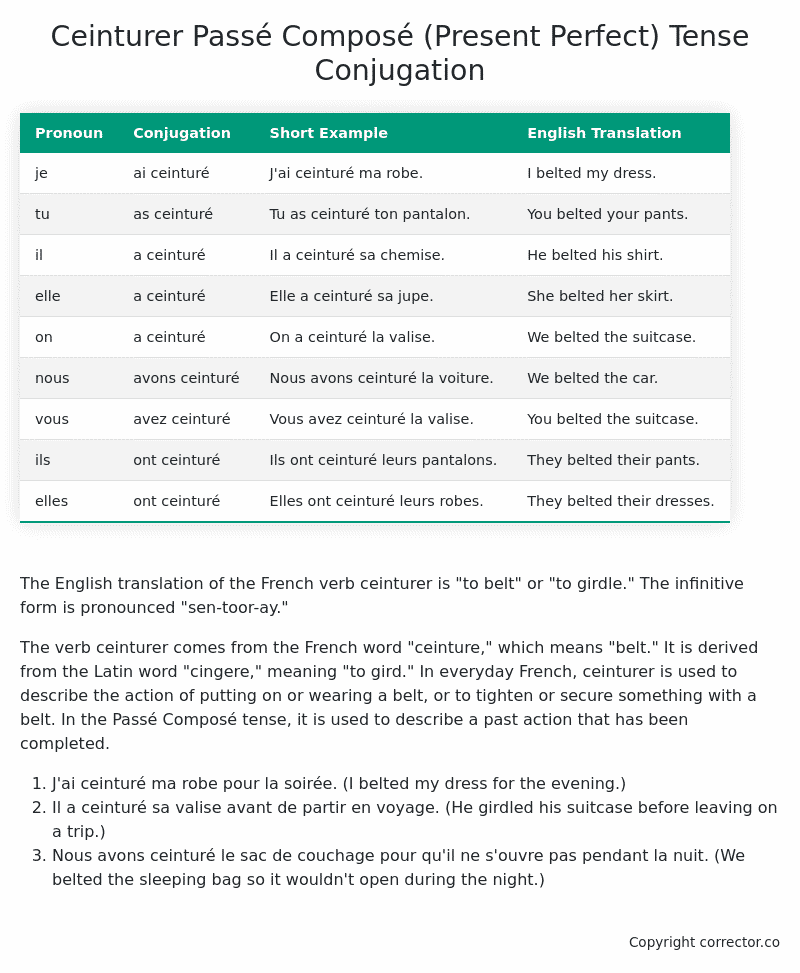Passé Composé (Present Perfect) Tense Conjugation of the French Verb ceinturer
Introduction to the verb ceinturer
The English translation of the French verb ceinturer is “to belt” or “to girdle.” The infinitive form is pronounced “sen-toor-ay.”
The verb ceinturer comes from the French word “ceinture,” which means “belt.” It is derived from the Latin word “cingere,” meaning “to gird.” In everyday French, ceinturer is used to describe the action of putting on or wearing a belt, or to tighten or secure something with a belt. In the Passé Composé tense, it is used to describe a past action that has been completed.
- J’ai ceinturé ma robe pour la soirée. (I belted my dress for the evening.)
- Il a ceinturé sa valise avant de partir en voyage. (He girdled his suitcase before leaving on a trip.)
- Nous avons ceinturé le sac de couchage pour qu’il ne s’ouvre pas pendant la nuit. (We belted the sleeping bag so it wouldn’t open during the night.)
Table of the Passé Composé (Present Perfect) Tense Conjugation of ceinturer
| Pronoun | Conjugation | Short Example | English Translation |
|---|---|---|---|
| je | ai ceinturé | J’ai ceinturé ma robe. | I belted my dress. |
| tu | as ceinturé | Tu as ceinturé ton pantalon. | You belted your pants. |
| il | a ceinturé | Il a ceinturé sa chemise. | He belted his shirt. |
| elle | a ceinturé | Elle a ceinturé sa jupe. | She belted her skirt. |
| on | a ceinturé | On a ceinturé la valise. | We belted the suitcase. |
| nous | avons ceinturé | Nous avons ceinturé la voiture. | We belted the car. |
| vous | avez ceinturé | Vous avez ceinturé la valise. | You belted the suitcase. |
| ils | ont ceinturé | Ils ont ceinturé leurs pantalons. | They belted their pants. |
| elles | ont ceinturé | Elles ont ceinturé leurs robes. | They belted their dresses. |
Other Conjugations for Ceinturer.
Le Present (Present Tense) Conjugation of the French Verb ceinturer
Imparfait (Imperfect) Tense Conjugation of the French Verb ceinturer
Passé Simple (Simple Past) Tense Conjugation of the French Verb ceinturer
Passé Composé (Present Perfect) Tense Conjugation of the French Verb ceinturer (this article)
Futur Simple (Simple Future) Tense Conjugation of the French Verb ceinturer
Futur Proche (Near Future) Tense Conjugation of the French Verb ceinturer
Plus-que-parfait (Pluperfect) Tense Conjugation of the French Verb ceinturer
Passé Antérieur (Past Anterior) Tense Conjugation of the French Verb ceinturer
Futur Antérieur (Future Anterior) Tense Conjugation of the French Verb ceinturer
Subjonctif Présent (Subjunctive Present) Tense Conjugation of the French Verb ceinturer
Subjonctif Passé (Subjunctive Past) Tense Conjugation of the French Verb ceinturer
Subjonctif Imparfait (Subjunctive Imperfect) Tense Conjugation of the French Verb ceinturer
Subjonctif Plus-que-parfait (Subjunctive Pluperfect) Tense Conjugation of the French Verb ceinturer
Conditionnel Présent (Conditional Present) Tense Conjugation of the French Verb ceinturer
Conditionnel Passé (Conditional Past) Tense Conjugation of the French Verb ceinturer
L’impératif Présent (Imperative Present) Tense Conjugation of the French Verb ceinturer
L’infinitif Présent (Infinitive Present) Tense Conjugation of the French Verb ceinturer
Struggling with French verbs or the language in general? Why not use our free French Grammar Checker – no registration required!
Get a FREE Download Study Sheet of this Conjugation 🔥
Simply right click the image below, click “save image” and get your free reference for the ceinturer present perfect tense conjugation!

Ceinturer – About the French Passé Composé (Present Perfect) Tense
Formation of the Passé Composé
Set the auxiliary verb with either
Conjugate the auxiliary verb
Add the past participle
Common everyday usage patterns
Narrating Past Events
Sequential Actions
Describing Completed Actions
Interactions with other tenses
Imperfect Tense
Conditional and Future Tenses
Summary
I hope you enjoyed this article on the verb ceinturer. Still in a learning mood? Check out another TOTALLY random French verb conjugation!


